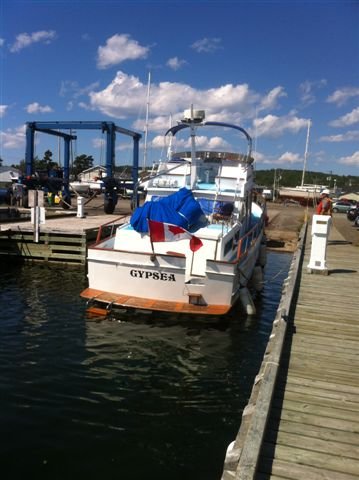About a week or so ago, someone posted a link to this great website that I find very informative – http://www.captainhugenot.com. I can't find the post now, so whoever recommended this, thank you.
At any rate, there is one article that I don't understand. It's regarding walking your boat sideways and there's either a mistake, or I'm missing something. I would like the great TF members opinions.
It states the following -
Suppose we have dock off our starboard side, and we want to “parallel park” our boat between two other boats on that same dock. We would simply turn our helm hard to starboard (or toward the dock when landing). Then, with the engines at idle, we would shift our outboard engine (the one farthest from the dock) to provide reverse propulsion, and shift our inboard (the one closest to the dock) to provide forward propulsion.
The astern thrust of the outboard engine and the forward thrust of the inboard engine will tend to turn our bow away from the dock. However, the thrust from the inboard engine impinging upon the rudder surface will tend to push the bow toward the dock – and these two effects will cancel each other out, leaving the boat idle.
Since both propellers are now turning clockwise ( port is left handed, starboard is right handed) this provides a “paddlewheel effect” of moving the boat to the right. The net effect is a movement sideways to starboard toward the dock.
Of course, if it were that simple, everyone would find it easy.
However, the opposing thrust of the two propellers has a greater turning force that the prop wash against only one rudder, and so our bow may head in slightly quicker that our stern. If we don't stop this turning, we will soon be headed straight for the dock – bow first. . . . .
Everything makes sense to me except the last paragraph. It states that the opposing thrusts have the greatest effect, yet it says the bow will be turning into the dock. It makes sense to me that the bow will still be turning away from the dock as stated in the second paragraph.
Here is the link to the article that also has diagrams - http://www.captainhugenot.com/images/TWIN-SCREW_06-2004.pdf
Is this a mistake in the article or am I missing something?
At any rate, there is one article that I don't understand. It's regarding walking your boat sideways and there's either a mistake, or I'm missing something. I would like the great TF members opinions.
It states the following -
Suppose we have dock off our starboard side, and we want to “parallel park” our boat between two other boats on that same dock. We would simply turn our helm hard to starboard (or toward the dock when landing). Then, with the engines at idle, we would shift our outboard engine (the one farthest from the dock) to provide reverse propulsion, and shift our inboard (the one closest to the dock) to provide forward propulsion.
The astern thrust of the outboard engine and the forward thrust of the inboard engine will tend to turn our bow away from the dock. However, the thrust from the inboard engine impinging upon the rudder surface will tend to push the bow toward the dock – and these two effects will cancel each other out, leaving the boat idle.
Since both propellers are now turning clockwise ( port is left handed, starboard is right handed) this provides a “paddlewheel effect” of moving the boat to the right. The net effect is a movement sideways to starboard toward the dock.
Of course, if it were that simple, everyone would find it easy.
However, the opposing thrust of the two propellers has a greater turning force that the prop wash against only one rudder, and so our bow may head in slightly quicker that our stern. If we don't stop this turning, we will soon be headed straight for the dock – bow first. . . . .
Everything makes sense to me except the last paragraph. It states that the opposing thrusts have the greatest effect, yet it says the bow will be turning into the dock. It makes sense to me that the bow will still be turning away from the dock as stated in the second paragraph.
Here is the link to the article that also has diagrams - http://www.captainhugenot.com/images/TWIN-SCREW_06-2004.pdf
Is this a mistake in the article or am I missing something?

